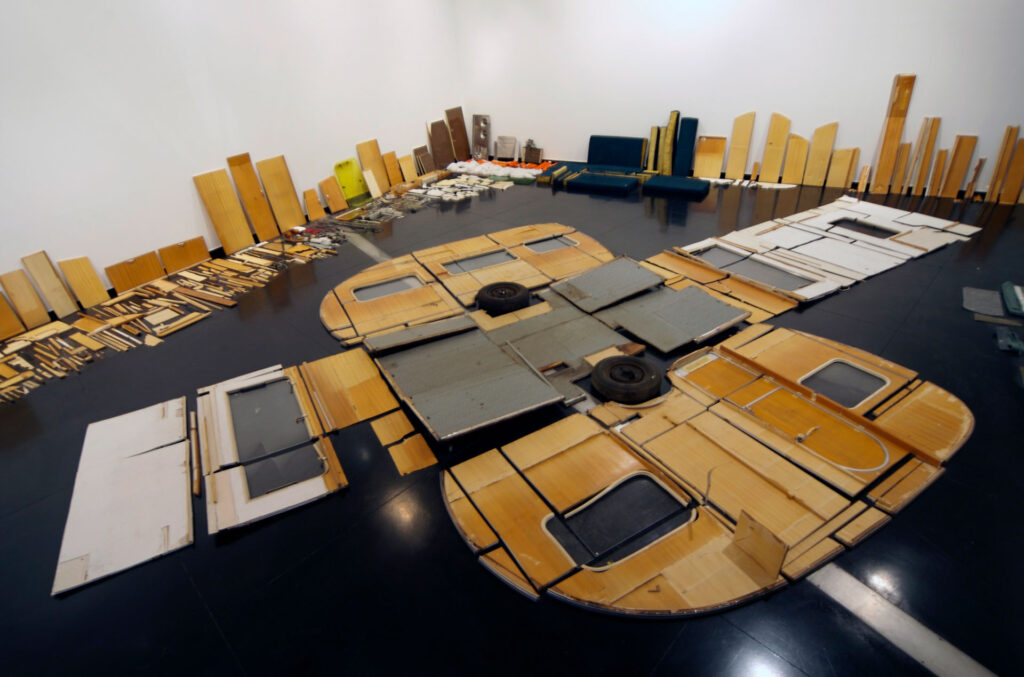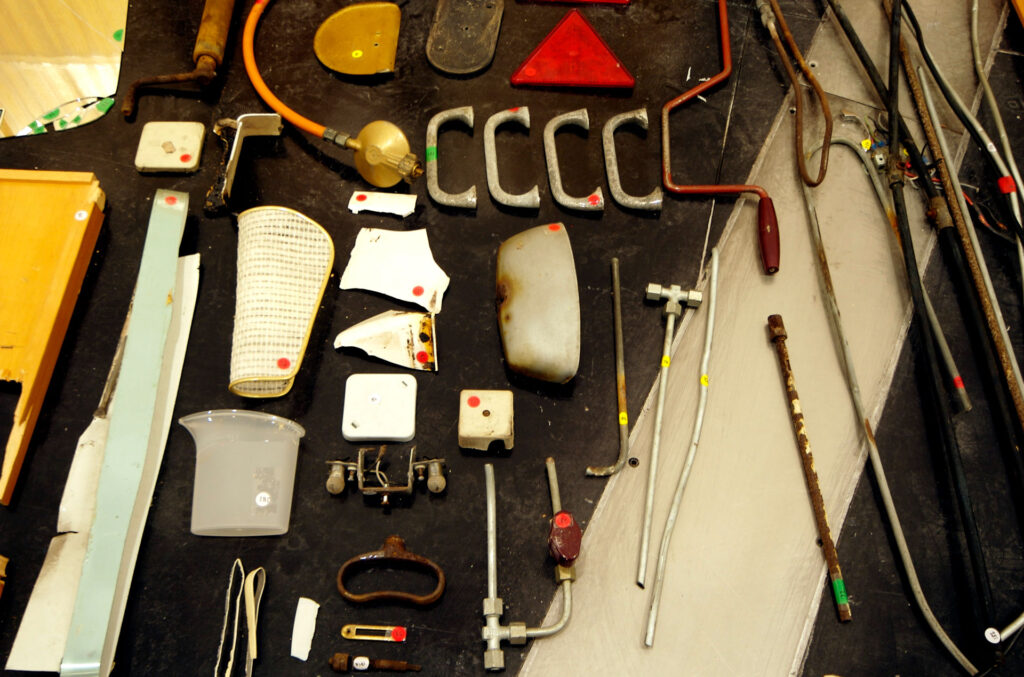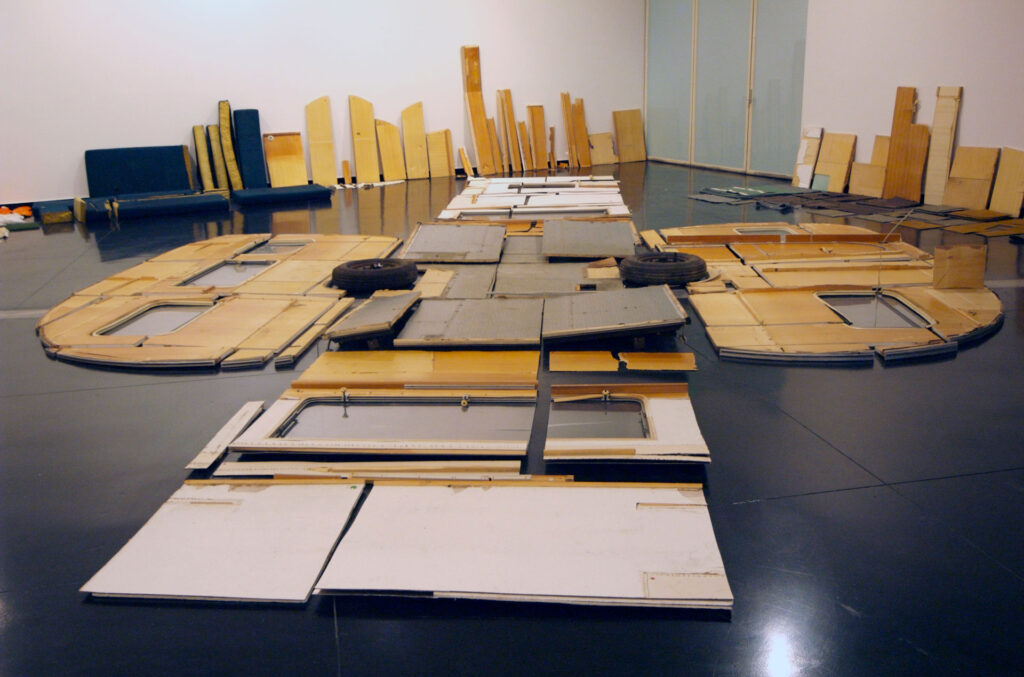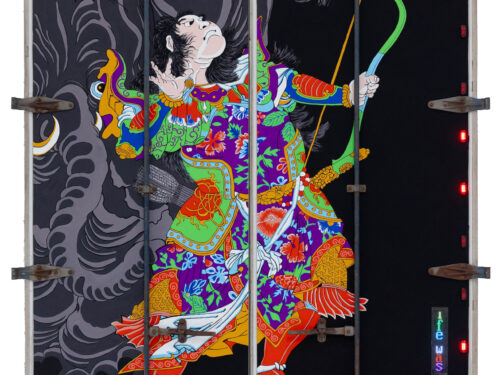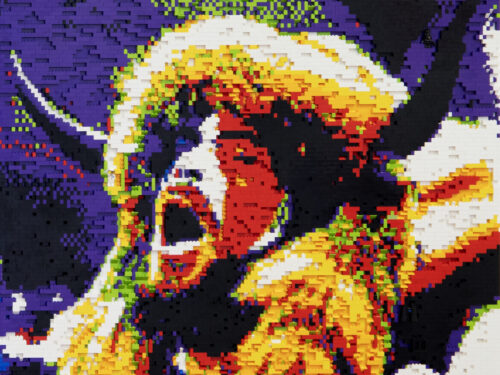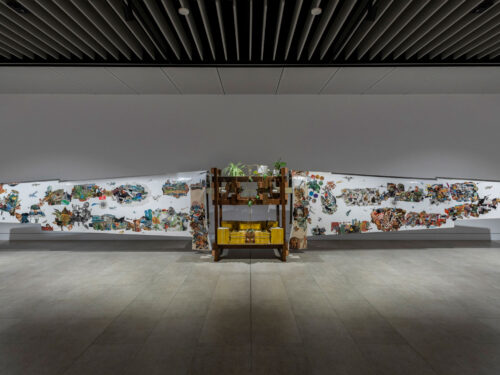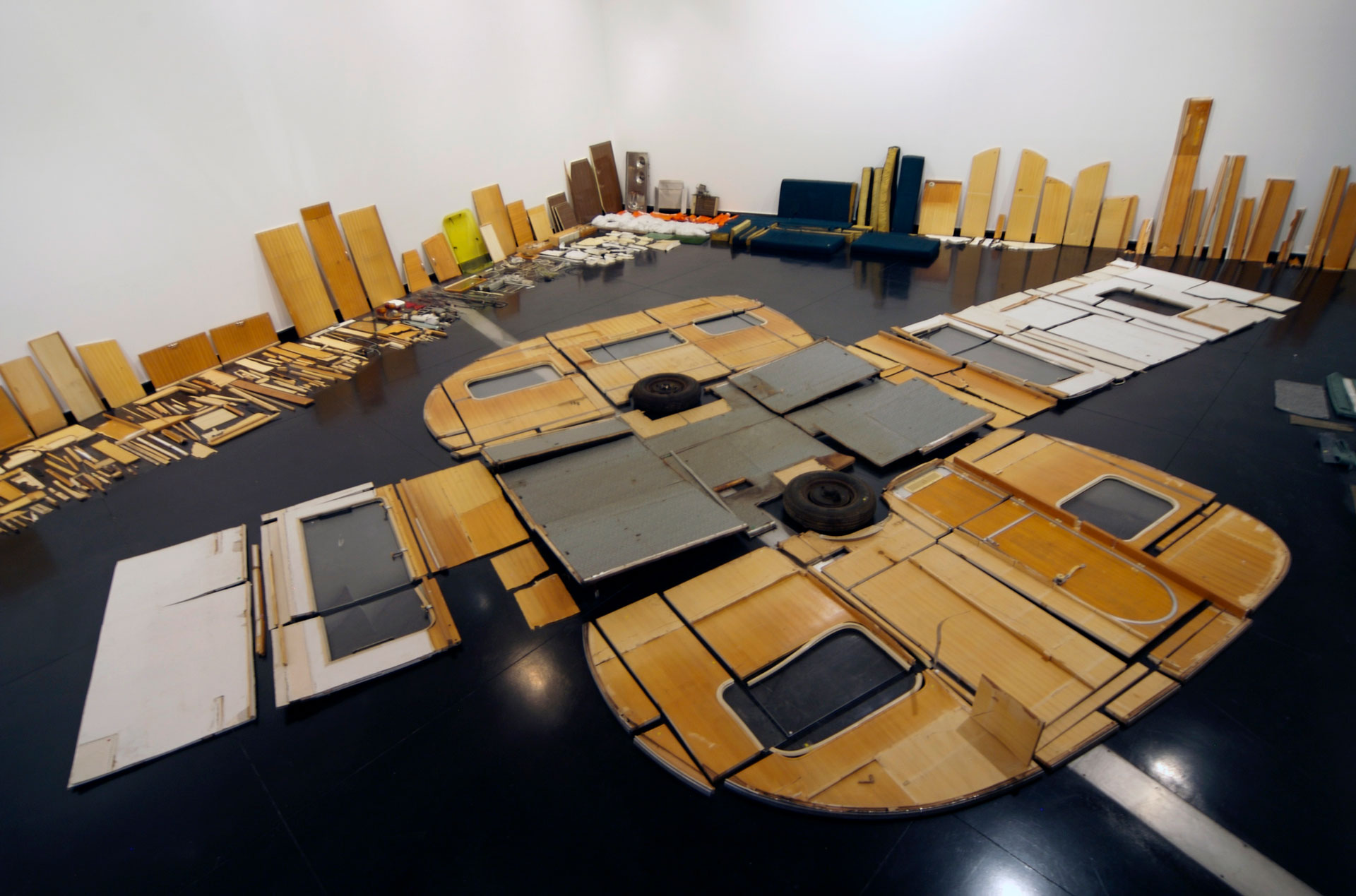
Past Times
Words by Jonathan Turner
In those old Road Runner cartoons, the wily coyote sits astride rockets, motorbikes and all types of fast-moving projectiles in his desperate bid to catch his lunch. Time and again, as the coyote is catapulted along desert roadways, the camera focuses on him, while the landscape behind him passes by in a repetitive loop. Cactus, boulder, cloud, cactus, boulder, cloud. It is a reversal of the natural order of things. The animated, high-velocity figure is static, framed and unchanging. The surroundings move instead.
In Past Times, the travelling caravan-based project by Claire Healy & Sean Cordeiro, a formerly dynamic object is transformed into an immobile installation, although its transport to the exhibition venue is itself an integral part of the concept. On the floor, we see neatly ordered elements from a carefully dismembered caravan. From our elevated vantage point, we scan over the spare parts as we attempt to decipher their l purpose within the original structure of the caravan. As we move and change our viewpoint, the flat perspective shifts like the landscape in a cartoon. Here the artists’ vision of travel is different. The mobile symbol of a leisurely vacation is recast as a cumbersome mathematical puzzle.
A caravan is a container of dreams, a safe enclosure, a roving gypsy’s refuge. It represents shelter from the elements, a home away from home, a place of joy and secrets. However, in the hands of Healy & Cordeiro, this mobile Pandora’s box is reduced to its deconstructed parts, devoid of mystery. Their suburban caravan is no romantic nomad, but the ultimate middle-class vacation vehicle, rendered useless. In an act of reverse logics, simultaneously overcoming the foibles of freight, Healy & Cordeiro have dismantled and cut up an ordinary German caravan and shipped it back to Australia, like sliced lunch. The mode of holiday transport itself has become the pre-packaged tourist. But it in its new form, it is virtually unrecognisable. Like at the beginning of a televised cooking programme where all the necessary ingredients have been neatly chopped and prepared, if the menu has not yet been announced, you don’t know whether the chef is making a savoury dish or a sugary cake.
According to the artists, this new project emerged from their previous work Flatpack. “The caravan was dismantled so that most of the pieces fit neatly into the rectangular 120 x 80cm dimensions of a standard Euro-pallet, for transportation from Berlin to Australia. These pieces are placed together as a flat assemblage, as though it is a jigsaw puzzle on the floor at the Australian Centre for Contemporary Art. Although the whole installation may seem fragmented and scattered, there is a unifying dimension to the pieces. Even in its sprawl, razor-sharp edges and perfect right angles are evident, indicating that certain care has been taken in the initial disassembly. The careful packing and stacking at the first stage ensured that a maximum of material could fit into each box.”
Due to space constraints, inside a caravan, everything has its own proper place. Life is neatly compartmentalized and streamlined. Now, in Healy & Cordeiro’s catalogue of materials, space considerations have been overturned. The installation is only a partially honest archive of the caravan’s own manufacture, since some parts have been modified to suit international transport specifications.
At the same time, we are reminded of the scene after an aeroplane disaster, when the sections recovered from the crash site are spread out in an attempt to determine the cause of the accident. Catastrophe, dislocation and consequence. In Healy & Cordeiro’s patchwork version of contemporary archaeology, however, no attention is paid to the former function of the materials. So the holiday home is no longer a piece of road-worthy real estate, but the staged scene of an invented diaster or a disastrous inventory.
“We are creating some kind of order out of disorder, tidying up the fragments in attempt to mend what has been fractured,” say the artists. “We will construct a wooden viewing platform in the corner of the space. The platform is only a metre or so high. The lookout will be similar to what you may come across whilst on a walking trail in the bush. There will also be two large-scale photographs on the walls opposite the viewing tower. One of the photos will be of the caravan before deconstruction, the other will be of the crates in which the caravan was transported. In essence, Past Times is partially reconstructing a holiday experience (the caravan) within the parameters of a holiday experience (the viewing platform).”
Healy & Cordeiro currently reside in Berlin. They have recognized that just like the Trabant (a much-scorned East-German family sedan), the bulky image of the post-war German caravan can still conjure up strong emotions and responses. These include the dismay of a driver being stuck on a winding country road behind a car towing a caravan, the nostalgia of misty-eyed recollections of innocent summer holidays, or the cliché social implications as held by snobs (the disturbing ability to transport the chattering middle-classes, complete with their Tupperware containers and fold-out chairs, into the midst of the previously pristine wilderness). Its ingrained sub-urbanity has even inspired a suitably drab drag name – Kara Van Park.
While Healy & Cordeiro are charting the territory in their own specific manner, they are not alone in their use of the mobile home as a metaphor to comment on modern dilemmas. In their first collaborative project in1996, Carsten Holler and Rosemarie Trockel created their Mosquito Bus from a Volkswagen Kombi van, in which a swarm of biting insects were locked inside rather than shut out. More recently, Austria’s Hans Schabus sliced his car in half to build a trailer, which he then closely documented as it was hauled uselessly around Vienna. Unlike Andrea Zittel’s Wagon Stations in California, (small capsules that resemble car-towed camping trailers) or the felt-lined, feel-good refuges created by Holland’s Atelier van Lieshout, Healy & Cordeiro’s work is about deconstructing the myth of cosiness, dissembling the inaccurate memories of holiday fun. They discuss the ideas of forgetfulness, dementia and cerebral disconnection to the past.
Like the artists themselves, Claire & Sean’s large-scale works are steered by a highly social attitude. For example, when we recently met up in Rome, much time was spent talking over beers about such ideas as the old order confronting the new disorder, the complexities of modern transport and the concept of the “invader” being welcomed by the local inhabitant, all subjects particularly relevant to the installation here at ACCA. As ever, in their work, the essential discourse is the role of willing witness versus participant.
Daily, many of us navigate through tourist-saturated spaces. The archaeological “excavation” and display of a European caravan in an institution in Melbourne, complete with a specially constructed viewing platform, is a meditation on the purpose of tourism today. What are people trying to construct in their heads by going abroad or living in motion. Are we literally looking at the cogs of tourism? In the end, if you keep to the rules, everything is transportable. Hence Healy & Cordeiro’s caravan installation is not merely the flattened husk of a portable home. After scrutiny, the sum of its parts is more than just some of its parts.
Jonathan Turner, Rome/Sydney
